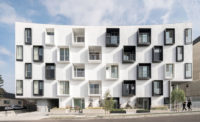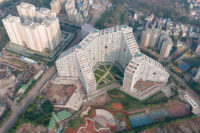Monterrey, Mexico
When Michel Rojkind calls Highpark “extroverted,” you might think, “It takes one to know one.” An exuberant character, the Mexico City–based architect is rarely at a loss for words or enthusiasm. His new housing project in Monterrey, a major industrial and business center in northeast Mexico, shares his outgoing personality—engaging its urban context and striking an animated profile on the street.
Set in the upscale San Pedro Garza García area on the outskirts of Monterrey, where the Sierra Madre Oriental mountain range serves as a dramatic backdrop, Highpark combines 31 very large luxury apartments—some as big as 7,000 square feet—with retail space and restaurants on the ground floor and offices on the second floor. Three and a half floors of parking below grade free up the street level for a generous public plaza in front of the building. “Most developers put up gated apartment buildings here,” using fences and walls to give residents a sense of security, says Rojkind. “But we opened Highpark to the city, so anyone can sit in front or use the restaurants.” This strategy has helped commercial tenants on the ground floor. A café called Mofin just opened, before the first residents are set to move in, and is already doing a brisk business with people in the neighborhood, some with babies in strollers and others tapping at laptops. Four restaurants are under construction, as is a tailor shop that will also serve drinks. The complex uses the active presence of visitors and residents—as well as closed-circuit cameras—to deal with security concerns.
Highpark’s curving floor plates, which recall topographic lines on a map, wrap around the front plaza in a welcoming embrace. Trees, benches, and tables beckon visitors to come and hang out, and only a few broad steps separate the project from the adjacent street. To further a sense of connection, Rojkind even proposed to city officials that the street be treated as an extension of the landscaped open space, but was rebuffed.
Wanting to tie the building visually to the mountains behind it, the architect used a dark slate-like stone installed in panels. Arranged in vertical strips that protrude at slightly different depths, the cladding catches sunlight and creates slivers of shadows that add texture to the facades. While many new buildings, with their smooth glass skins, can seem thin, Highpark tries to impress us with a depth and weight that are almost geological in character.
Rojkind’s design provides multiple outdoor spaces for most apartments. On the north facade, every other floor is pushed out, creating balconies and shading the apartments below. On the west, the building steps back as it goes up, producing more terraces. Living walls, sprouting native plants, separate some of these outdoor rooms, and most are landscaped with species appropriate for the semi-arid climate.
Understanding that the climate here can be both enticing and harsh, Rojkind used a range of devices to connect residents to the outdoors. At the ground level, he decided not to enclose the lobby, instead carving out a shaded space in the middle of the building that flows directly from the front plaza. A shaded balcony on the second level provides access to offices, while on upper floors, some apartments have recessed terraces to serve as cool transitions between indoors and out.
Like most luxury-housing complexes, Highpark offers a package of amenities—swimming pool, meeting rooms, and gym—but complements them with communal decks that are landscaped and designed so that they are more than just throwaway spaces. Located on the sixth and seventh floors, these indoor and outdoor facilities serve as hubs for shared activities.
A steel-frame structure with lightweight-concrete floor slabs, Highpark offers apartments ranging in size from 1,950 square feet to 7,000, none with the same layout and some sprawling across two levels. Marketed as an alternative to single-family houses, the units need to be big enough to convince people to make the move. More than half of the residences have been sold so far, mostly to young professionals and empty-nesters, reports Monica Villatoro, a development executive with Orange Investments, which serves as the owner’s representative for the project. A few buyers are from Mexico City and Guadalajara, but most are from Monterrey, says Villatoro. “This isn’t an investment; it’s for themselves,” she explains. The company invited four local designers—Mauricio Lobeira, Edmundo Salinas, Ernesto Vela, and Mauricio de la Garza—to create the apartment interiors.
Although not envisioned as a “green” building, Highpark employs a number of sustainable-design strategies, such as recycling rainwater and using graywater for irrigation. Its stone exterior and overhanging terraces reduce solar loads, and more than two-thirds of interior spaces have multiple exposures so they can be cross ventilated. Rojkind admits, though, that most people in Monterrey love their air-conditioning and may not open their windows to take advantage of cooling breezes.
Bucking the trend of thin-skinned apartment towers hermetically sealed against the elements, Highpark engages in a lively back-and-forth between inside and out. In form and in spirit, the building reaches out to its surroundings and invites the neighbors inside.
Size: 375,000 square feet
Cost: withheld
Completion date: June 2015
PeopleOwner: Undisclosed
Architect:
Interior designer:
Local Firm (CDD)
Engineer(s):
MEP: Quantum
Consultant(s):
Lighting:
Acoustical:
Principal contractor:
Photographer(s):
Renderer(s):
CAD system, project management, or other software used: |
Products
Structural system Execution: Constructora Maiz Mier
Concrete structure and concrete slabs are used for a 4 level basement. Full structural contention of the basement has an underflow abating system both passive (consisting of natural filters) and electromechanical (hydraulic pumping)
Green Roofing:
Windows Glass: VITRO Aluminum: CUPRUM Execution: Mercado Vidrio Plano
Doors Wood Doors for the apartments entrances: Bucca Metal doors for emergency exits and other services: Metropolitan Doors Acoustic Doors for HVAC Areas: Metropolitan Doors Glass sliding doors to all terraces: Mercado Vidrio Plano, Glass: VITRO
Hardware Equipment: Bosch Execution: DOT Dcd
Interior finishes Comex Paints Cuarcita stone for the façade, black granite for the exterior flooring and tazmania limestone for the flooring (Marmoles Arca)
Lighting
Conveyance Accessibility provision : Full accessibility building (through ramping and elevators)
Plumbing
Energy
Other unique products that contribute to sustainability: |













Post a comment to this article
Report Abusive Comment